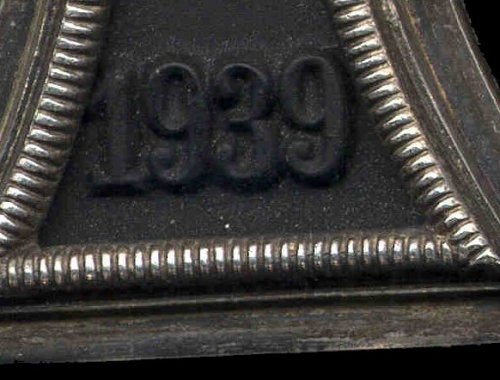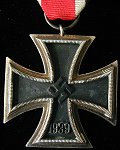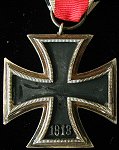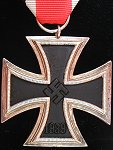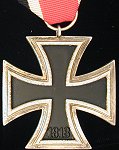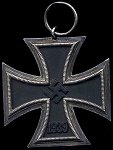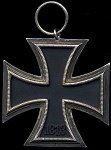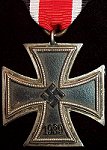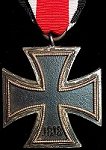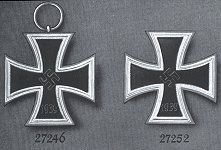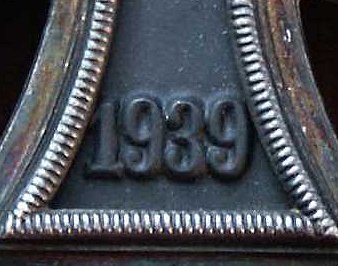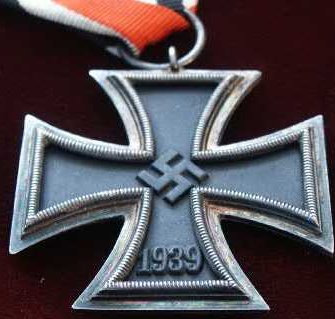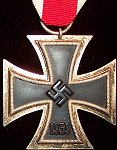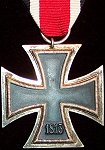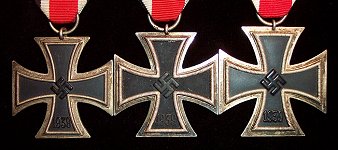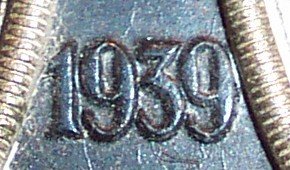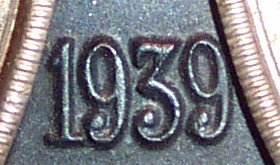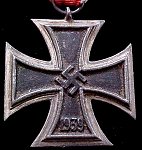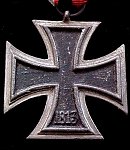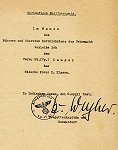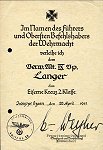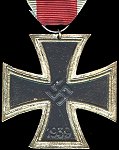
by Sebastián J. Bianchi
The Iron Cross Second Class held a certain level of prestige in the waning days of 1939; in war's past, even this lowest grade had been stringently presented. However, as the conflict entered advanced years, and certainly as the German infrastructure crumbled in 1945, this grade was given out with liberalism and therefore its reputation eroded accordingly. In spite of this, the Iron Cross 2nd Class was a valued decoration and many recipients have proudly documented the deeds which earned them the right to wear it.
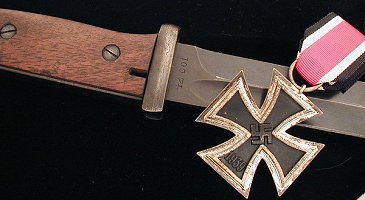
Award Criteria
The official criteria for the award was a single act of bravery in
the face of the enemy, or actions that were clearly above and beyond the
call of duty.
Heer and SS personnel would receive the Cross for a successful action
in which the soldier distinguished himself. For example, Platoon
commander SS Obersturmfuhrer Eric Brorup of the 5th SS Panzer Division
was decorated on December 1, 1942 for leading a reconnaissance forest
raid in the Eastern front during which a fire fight ensued. His platoon
inflicted enemy casualties and brought back six prisoners, two of them
NCOs. It was not uncommon for an entire unit to receive the
Iron Cross 2nd Class. The entire crew of U-29 was decorated on
September 18th in recognition of their sinking of the 22,500 aircraft
carrier HMS Courageous on the previous day.
Wear
The class of the award was worn in three different methods
- From the second button of the tunic.
- When in formal dress, the entire cross was worn mounted alone or as part of a medal bar.
- For everyday wear, only the ribbon was worn from the second hole in the tunic button.
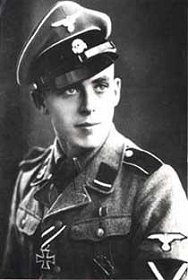 |
1)
SS Oberschutze |
|
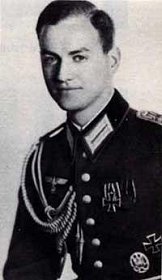 |
2) Siegfried Knappe wears the medal on a bar. |
|
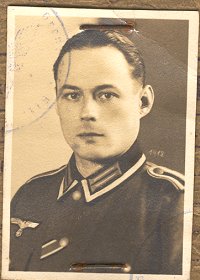 |
3) Hubert Berg wears just the ribbon on his Soldbuch photo. |
|
Sebastián Bianchi collection |
||
For more information, see the recipient section of this article.
Manufactures
The 2nd Class of the Iron Cross measured 44mm in diameter and was held by a black, white and red ribbon representing the colors of the new Reich. For complete manufacturing information please see the Manufacturing Section of this article. Once the basic cross was manufactured, a ring was soldered to the upper arm, and this in turn chain linked with the loop through which the ribbon passed (on a standard Iron Cross 30mm was presented with the award). The central stripe of the cloth measured 14mm with the black and white stripes measuring 4mm each.
Manufacturer mark, if present, was on the ribbon loop. Many Iron Crosses were unmarked and the absence of a stamp mark is common.
Click on images to enlarge
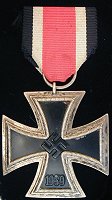 |
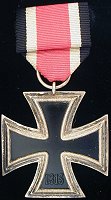 |
|
Standard Iron Cross Sebastián Bianchi collection | |
Manufacturer Gallery
The following firms manufactured the Iron Cross 2nd Class during the Third Reich period. Click on each manufacturer to see an example of the cross. These crosses are featured because they are marked, but the lack of a mark is also completely normal. In many cases, the manufacturer of a cross without a mark may be deduced by comparing it to a marked example. Be aware that there are variations within manufacturers and the ones presented here are representative of the maker, but by no means the last word on them.
Click on each manufacturer to see examples
FIRM # |
FIRM |
LOCATION |
| 1 | Deschler & Sohn | München |
| 2 | C.E. Juncker | Berlin |
| 3 | Wilhelm Deumer | Lüdenscheld |
| 4 | Steinhauer & Lück | Lüdenscheld |
| 5 | Hermann Wernstein | Jena-Lobstedt |
| 6 | Fritz Zimmermann | Stuttgart |
| 7 | Paul Meybauer | Berlin |
| 8 | Ferdinand Hoffstädter | Bonn |
| 11 | Grossmann & Co. | Wien |
| 12 | Frank & Reif | Stuttgart-Zuffenhausen |
| 13 | Gustav Brehmer | Markneukirchen/Sa |
| 16 | Alois Rettenmaler | Schwäblsch-Gmund |
| 15 | Friedrich Orth | Wien |
| 19 | E. Ferd Weidmann | Frankfurt/Main |
| 20 | C.F. Zimmermann | Pforzheim |
| 21 | Gebr. Godet & Co. | Berlin |
| 22 | Boerger & Co. | Berlin |
| 23 | Arbeitsgemeinschaft für Heereshedarf in der Graveur-ubd Ziselierung | Berlin |
| 24 | Arbeitsgemeinschaft der Hanauer Plakettenhersteller | Hanau |
| 25 | Arbeitsgemeinschaft der Graveur-Gold-und Silverschmeide-Innungen | Hanau |
| 26 | B. H. Mayers Kunstprägesanstalt | Pforzheim |
| 27 | Anton Schenkls Nachfolger | Wien |
| 33 | Friedrich Linden | Lüdensched |
| 35 | F.W. Assmann und Söhne | Lüdensched |
| 40 | Berg & Nolte | Lüdensched |
| 41 | Gebrüder Bender | Oberstein/Nahe |
| 42 | Biedermann & Co. | Oberkassel bei Bonn |
| 44 | Jakob Bengel | Idar/Oberdonau |
| 49 | Josef Feix Söhne | Gablonz a.d.Neckar |
| 52 | Gottlieb & Wagner | Idar Oberstein |
| 55 | J.E. Hammer & Söhne | Geringswalde |
| 56 | Robert Hauschild | Pforzheim |
| 65 | Klein & Quenzer A.G. | Idar Oberstein |
| 66 | Freidrich Keller | Oberstein |
| 70 | Lind & Meyrer | |
| 75 | (Unknown) | |
| 76 | Ernst L. Müller | Pforzheim |
| 80 | G.H. Osang | Dresden |
| 93 | Richard Simm & Söhne | Gablonz a.d.Neckar |
| 94 | Adolf Scholze | Grünwald a.d.Neckar |
| 96 | (Unknown) | |
| 97 | (Unknown) | |
| 98 | Rudolf Souval | Wien |
| 100 | Rudolf Wächtler & Lange | Mittweida |
| 103 | Aug. G. Tam | Gablonz a.d. Neckar |
| 104 | Hein. Ulbricht's Ww. | Kaufing bei Schwanenstadt |
| 106 | Brüder Schneider A.G. | Wien |
| 108 | Arno Wallpach | Salzburg |
| 109 | Walter & Hentein | Gablonz |
| 113 | Hermann Aurich | Dresden |
| 120 | Franz Petzl | Wien |
| 122 | JJ. Stahl | Strassburg |
| 123 | Beck, Hassinger & Co. | Strassburg |
| 125 | Eugen Gauss | Pforzheim |
| 128 | S. Jablonski Gmb H | Posen |
| 132 | Franz Reischauer | Oberstein |
| 137 | J.H. Werner | Berlin |
| 138 | Julius Maurer | Oberstein |
| 139 | Hymmen & Co. | Ludenscheid |
| FIRM # | FIRM | LOCATION |
|---|---|---|
| L/11 | Wilhelm Deumer | Lüdensched, Postfach 161 |
| L/12 | C. E. Juncker | Berlin SW 68, Alte Jakobstr. 13 |
| L/14 | Friedrich Orth | Wien |
Mounting Styles
When the cross was worn in full dress, several options were used to hold it. Below are three examples of such options, the Austrian three folded ribbon, the traditional "court mounted" (single mounted medal bar) and as part of a small medal group.
Click on images to enlarge
 |
 |
Austrian mounting
style.
G. Stimson Collection |
 |
 |
Court Mounted, or
single ribbon bar of the Iron Cross 2nd Class.
G. Stimson Collection |
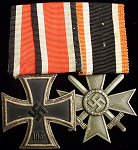 |
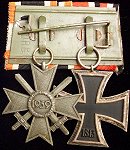 |
An Iron Cross on a
medal bar.
Sebastián Bianchi collection |
Variations
Round 3
This variation of the Iron Cross is fittingly called "round 3" since the "3" in the dates differs from the norm in that it is round on top (instead of flat).
|
|
|
Above is a clear example of a "round 3" (on the left), clearly different than the standard "3" on the right.
|
Click on images to enlarge
|
Tim Calvert Collection |
|
|
Übergrosse
The so called "Oversize" or Übergrosse Iron Crosses are larger in size than the standard 44mm by 44mm, their size being 47.5mm by 47.5mm. The original reason for these crosses being larger than standard has been lost to time, but whatever it was they were eventually issued as "regular" 2nd classes, despite their size.
Click on images to enlarge
Schinckelform
This variant of the 2nd and 1st Class derives its name from the creator of the award because of its similarities to the original Iron Cross design. So called "Schinckelform" Iron Crosses are early manufactured pieces that were made from 1914 dies, and therefore have narrower arms and smaller, more delicate features.
Click on images to enlarge
 |
 |
Schinckelform Iron Cross
Sebastián Bianchi collection |
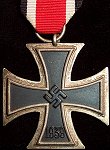 |
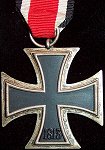 |
Schinckelform Iron Cross
George Stimson Collection |
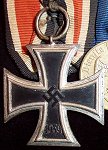 |
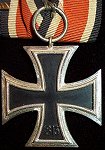 |
Court mounted Schinckelform
Iron Cross
George Stimson Collection
|
|
Two of the different date styles found on the Schinckelform. |
|
|
|
|
2nd Class-to-Knights Cross Conversion
There are many documented examples of a Knight's Cross recipient converting his Iron Cross 2nd Class for wear around his neck. A range of methods were used to accomplish the task, from professional conversions where a hook was soldered by a jeweler to more improvised, "field" methods. This promotion of the second class could be done on a temporary basis while a Knights Cross was not available or (and this is speculation) in order to protect the most prestigious award. From a collectors standpoint, if a converted Iron Cross is able to establish provenance then the price increases, if not, they are a tough sell.
Click on images to enlarge
Luftwaffe pilot
Walter Stumpf, who was awarded the Knights Cross late in
the war, never received the actual award and instead wore a
converted Iron Cross 2nd Class.
Andy Hopkins Collection | |
An example of a converted
Iron Cross 2nd Class.
Pascal Collection |
Field Made Iron Cross
Field Made Iron Crosses were made in the field, as the name obviously implies, where conditions prevented the delivery of an officially manufactured award. This was often the case in ships at seas and below we have a great example of a field made award from the ship Orion, and an exclusive photograph validating its manufacture. As with the converted Iron Cross, provenance is everything when dealing with a piece that purports to be field made. Alone they are nothing more than a novelty at best, but accompanied by appropriate documentation they are an exciting variation. Unfortunately, a field made Iron Cross is not often encountered, and one with documentation can be considered to be extremely rare.
Click on images to enlarge
Spanish Produced
Spanish mints also produced Iron Crosses during and after World War II. The quality of these crosses is generally inferior to their German counterparts, and they are constructed using a variety of methods and materials. These crosses also continued to be made after the war for veterans and collectors alike, since the swastika was not a prohibited symbol in Spain.
![]()
© Copyright Wehrmacht-Awards.com LLC |

